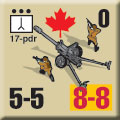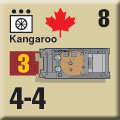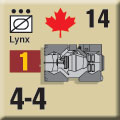| Maple Leaf Brigade:
Canadian Forces
By Mike Bennighof, Ph.D.
April 2022
Note: Maple Leaf Brigade introduces the Canadian Brigade Group to Panzer Grenadier in an expansion set for the out of print Hammer & Sickle, Elsenborn Ridge and the out-of-print Road to Berlin or upcoming Fire and Sword. This download is a Gold Club exclusive.
Canadian troops played a major role in the defeat of Nazi Germany, fighting across northern France, Belgium and the Netherlands in three infantry and two armored divisions, plus supporting units. Afterwards, Canadian units participated in the occupation of Germany but steadily drew down their strength until all had returned home by the end of 1946.
 Within a few years, Canada found it needed soldiers again. In 1951 a battalion went to Korea, later expanding to a full brigade. In 1950 Canada had also pledged a brigade for the new NATO force to be established in Germany, and recruiting for the new brigade began in early 1951. In May 1951 each of the Reserve Force’s 15 battalions was asked to contribute one company either from its current strength or new recruits; by the end of the month over 12,000 men had volunteered, mostly new recruits though many of these “new” men were veterans. Within a few years, Canada found it needed soldiers again. In 1951 a battalion went to Korea, later expanding to a full brigade. In 1950 Canada had also pledged a brigade for the new NATO force to be established in Germany, and recruiting for the new brigade began in early 1951. In May 1951 each of the Reserve Force’s 15 battalions was asked to contribute one company either from its current strength or new recruits; by the end of the month over 12,000 men had volunteered, mostly new recruits though many of these “new” men were veterans.
 Training began in June, and initially the Canadian Army planned to equip the brigade with U.S.-supplied weapons for ease of supply – apparently NATO intended the Canadian brigade to operate with U.S. units, though this does not appear to have been formally stated. When the weapons did not appear in time to commence training, the Canadian Army – unwilling to delay its commitment – reached into its stocks of British-model weaponry to issue British small arms and 17-pounder anti-tank guns. The Americans supplied mortars and artillery, but not ammunition, and so these were also replaced with British models from Canadian stocks (25-pounder artillery pieces and 3-inch mortars) when the brigade arrived in Germany in October 1951. The promised American tanks never arrived – the U.S. Army couldn’t even meet its armor needs for the Korean Conflict then raging – and the Canadian brigade received Centurions instead. The Centurions remained the Canadian tank until 1968, when Prime Minister Pierre Trudeau insisted on purchasing new German-made Leopards rather than a British tank. Training began in June, and initially the Canadian Army planned to equip the brigade with U.S.-supplied weapons for ease of supply – apparently NATO intended the Canadian brigade to operate with U.S. units, though this does not appear to have been formally stated. When the weapons did not appear in time to commence training, the Canadian Army – unwilling to delay its commitment – reached into its stocks of British-model weaponry to issue British small arms and 17-pounder anti-tank guns. The Americans supplied mortars and artillery, but not ammunition, and so these were also replaced with British models from Canadian stocks (25-pounder artillery pieces and 3-inch mortars) when the brigade arrived in Germany in October 1951. The promised American tanks never arrived – the U.S. Army couldn’t even meet its armor needs for the Korean Conflict then raging – and the Canadian brigade received Centurions instead. The Centurions remained the Canadian tank until 1968, when Prime Minister Pierre Trudeau insisted on purchasing new German-made Leopards rather than a British tank.
 Like other brigades of Commonwealth armies, 27th Canadian Infantry Brigade (the brigade’s initial designation) was built around three infantry battalions. The initial brigade had one composite battalion of each of the Canadian Army’s three types of infantry: Rifles, Highlanders and Infantry. Intended to operate as an independent unit, the brigade also included signals, engineer, ambulance and other supporting units, plus a tank squadron (standard in post-war brigades) and an artillery regiment (a battalion in other armies). Like other brigades of Commonwealth armies, 27th Canadian Infantry Brigade (the brigade’s initial designation) was built around three infantry battalions. The initial brigade had one composite battalion of each of the Canadian Army’s three types of infantry: Rifles, Highlanders and Infantry. Intended to operate as an independent unit, the brigade also included signals, engineer, ambulance and other supporting units, plus a tank squadron (standard in post-war brigades) and an artillery regiment (a battalion in other armies).
 A new brigade rotated into Germany every two years, with almost all of the troops from the previous brigade returning home. In 1957 that changed, with the brigade staff and supporting arms remaining in place and the combat battalions rotating home every three years rather than two. Afterwards the brigade designation did not change, and remained 4th Canadian Infantry (later Mechanized) Brigade until it stood down in 1993. Additional rotations brought more reinforcements. The tank squadron was expanded to a full tank regiment (battalion), and the reconnaissance element added a helicopter squadron and expanded its armored cars to a full squadron. A new brigade rotated into Germany every two years, with almost all of the troops from the previous brigade returning home. In 1957 that changed, with the brigade staff and supporting arms remaining in place and the combat battalions rotating home every three years rather than two. Afterwards the brigade designation did not change, and remained 4th Canadian Infantry (later Mechanized) Brigade until it stood down in 1993. Additional rotations brought more reinforcements. The tank squadron was expanded to a full tank regiment (battalion), and the reconnaissance element added a helicopter squadron and expanded its armored cars to a full squadron.
 Unlike those of most NATO armies, the Canadian brigade’s troops were long-service volunteers and gained a reputation as one of the best formations in Europe. Initially part of the British Army of the Rhine, Canada put some restrictions on her brigade’s employment: it could only be deployed within the NATO area, and could not be broken up into smaller combat groups attached to non-Canadian units. Otherwise, the brigade’s combat service would be at the discretion of NATO’s commander-in-chief. After 1968, the brigade moved to become the mobile reserve for the American VII Corps. Unlike those of most NATO armies, the Canadian brigade’s troops were long-service volunteers and gained a reputation as one of the best formations in Europe. Initially part of the British Army of the Rhine, Canada put some restrictions on her brigade’s employment: it could only be deployed within the NATO area, and could not be broken up into smaller combat groups attached to non-Canadian units. Otherwise, the brigade’s combat service would be at the discretion of NATO’s commander-in-chief. After 1968, the brigade moved to become the mobile reserve for the American VII Corps.
 During its first years in Europe, the Canadian brigade relied on the British Army of the Rhine for logistical support, and as in the Second World War followed British doctrine in terms of weapons and organization. Each infantry battalion had four companies, each of three platoons (somewhat smaller than American or Soviet platoons). The troops carried British-made .303 Enfield rifles, supplemented by Sten submachine guns and supported by Bren and Vickers machine guns. During its first years in Europe, the Canadian brigade relied on the British Army of the Rhine for logistical support, and as in the Second World War followed British doctrine in terms of weapons and organization. Each infantry battalion had four companies, each of three platoons (somewhat smaller than American or Soviet platoons). The troops carried British-made .303 Enfield rifles, supplemented by Sten submachine guns and supported by Bren and Vickers machine guns.
The Canadians had wanted American-made 75mm and 105mm recoilless rifles to serve as infantry anti-tank weapons, along with the 3.5-inch “Super Bazooka” rocket launcher. The Americans could not initially provide these, and the Canadian brigade issued British PIAT spring-loaded launchers in their place.
 In our Iron Curtain: Maple Leaf Brigade, the Canadians are deployed as a “fire brigade” (the role foreseen for them by NATO’s first commander, Dwight D. Eisenhower) to resist a Soviet attack in October 1951 that forms the basis of our out-of-print (but available to the Gold Club) Iron Curtain: Hammer & Sickle book’s story arc. That takes place just as the Canadians are arriving in Germany, so we’ve posited that the heightening tensions described in Hammer & Sickle would have sped the Canadians’ return Europe. Canadian troops were already engaged in combat in Korea by that point, so Canada had proven its determination to resist Communist aggression by force of arms. Had NATO called for the Canadians to arrive earlier, they would have answered. In our Iron Curtain: Maple Leaf Brigade, the Canadians are deployed as a “fire brigade” (the role foreseen for them by NATO’s first commander, Dwight D. Eisenhower) to resist a Soviet attack in October 1951 that forms the basis of our out-of-print (but available to the Gold Club) Iron Curtain: Hammer & Sickle book’s story arc. That takes place just as the Canadians are arriving in Germany, so we’ve posited that the heightening tensions described in Hammer & Sickle would have sped the Canadians’ return Europe. Canadian troops were already engaged in combat in Korea by that point, so Canada had proven its determination to resist Communist aggression by force of arms. Had NATO called for the Canadians to arrive earlier, they would have answered.
The battles described never actually took place, but the brigade stood ready to fight them for 42 years. Now you can lead them.
Don’t wait to put Maple Leaf Brigade on your game table! Join the Gold Club and find out how to add it to your collection!
Sign up for our newsletter right here. Your info will never be sold or transferred; we'll just use it to update you on new games and new offers.
Mike Bennighof is president of Avalanche Press and holds a doctorate in history from Emory University. A Fulbright Scholar and NASA Journalist in Space finalist, he has published a great many books, games and articles on historical subjects; people are saying that some of them are actually good.
He lives in Birmingham, Alabama with his wife, three children, and his Iron Dog, Leopold.
Want to keep Daily Content free of third-party ads? You can send us some love (and cash) through this link right here.
|
